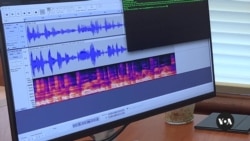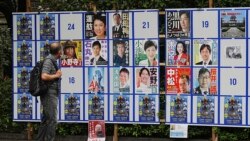ສຽງປອມຖືກນຳມາໃຊ້ໃນການພະຍາຍາມຊັກຈູງຜູ້ມີສິດເລືອກຕັ້ງໃນປີນີ້. ແມັດ ດິບເບີລ ຈາກສຳນັກຂ່າວ VOA ມາເບິ່ງກັນວ່າປັນຍາປະດິດສາມາດຊ່ວຍກວດສອບສຽງສັງເຄາະໄດ້ແນວໃດໃນລາຍການ LogOn ອາທິດນີ້, ເຊິ່ງ ທິບສຸດາ ມີລາຍລະອຽດມາສະເໜີທ່ານໃນອັນດັບຕໍ່ໄປ.
ຄວາມສາມາດໃນການສ້າງຂໍ້ຄວາມສຽງສັງເຄາະ ຫຼືທີ່ຮູ້ຈັກກັນໃນຊື່ສຽງປອມ (ດີບເຟກ), ຕອນນີ້ຢູ່ໃນມືຂອງທຸກຄົນທີ່ເຊື່ອມຕໍ່ກັບອິນເຕີເນັດ. ດ້ວຍການທີ່ມີກວ່າ 50 ລັດຈະຈັດການເລືອກຕັ້ງໃນປີນີ້, ຄວາມພະຍາຍາມໃນການກວດສອບຂໍ້ມູນທີ່ບໍ່ຈິງກ່ອນທີ່ມັນຈະກໍ່ໃຫ້ເກີດອັນຕະລາຍຈຶ່ງເພີ່ມຂຶ້ນ.
ທ່ານນາງ ຊາຣາ ແບຣິງຕັນ ຄົ້ນຄວ້າກ່ຽວກັບສຽງປອມ (ດີບເຟກ) ທີ່ມະຫາວິທະຍາໄລແຄລິຟໍເນຍ, ເບີກເລ.
ທ່ານນາງ ຊາຣາ ແບຣິງຕັນ ກ່າວວ່າ:
"ເຮົາຕ້ອງການພຽງແຕ່ຂໍ້ມູນບາງສ່ວນຈາກເຈົ້າ"
ໃນເວລາພຽງສອງສາມນາທີ, ລາວໄດ້ຮຽນແບບ ຫຼື ໂຄນສຽງຂອງຜູ້ສື່ຂ່າວຄົນນີ້ໂດຍໃຊ້ບໍລິການທາງອອນລາຍ ແລະ ສ້າງຂໍ້ຄວາມສັ້ນໆ ທີ່ເປັນສະບັບປອມ.
ທ່ານນາງ ຊາຣາ ແບຣິງຕັນ ກ່າວວ່າ:
"ສຽງແທ້ຂອງເຈົ້າເປັນແບບນີ້...ນີ້ແມ່ນປະໂຫຍກທົດສອບທີ່ຂ້ອຍໃຊ້ເພື່ອບອກຄວາມແຕກຕ່າງລະຫວ່າງຂອງຈິງ...ແລະ ນີ້ແມ່ນສະບັບ ຫຼື ເວີຊັນປອມຂອງເຈົ້າ..."
Matt Dibble
"ນີ້ແມ່ນປະໂຫຍກທົດສອບທີ່ຂ້ອຍໃຊ້ເພື່ອບອກຄວາມແຕກຕ່າງລະຫວ່າງຂອງຈິງ..."
ທ່ານນາງ ຊາຣາ ແບຣິງຕັນ ກ່າວວ່າ
"ໜ້າເຫຼືອເຊື່ອຫຼາຍ"
ທ່ານນາງ ຊາຣາ ແບຣິງຕັນ ກ່າວວ່າ:
"ສິ່ງທີ່ເຮົາເລີ່ມເຮັດແມ່ນນຳສິ່ງນີ້ເຂົ້າສູ່ຄອມພິວເຕີ ແລະ ເບິ່ງຮູບຄື້ນ ແລະ ສັນຍາລັກລົບກວນ ແລ້ວເລີ່ມຫາຄວາມແຕກຕ່າງ"
ບາງຈຸດສາມາດເຫັນໄດ້ດ້ວຍຕາເປົ່າສຳລັບຜູ້ທີ່ໄດ້ຮັບການຝຶກຝົນມາ, ເຊັ່ນ ການຢຸດຊະງັກທີ່ມະນຸດມັກເຮັດ.
ທ່ານນາງ ຊາຣາ ແບຣິງຕັນ ກ່າວວ່າ:
"ໂດຍທົ່ວໄປແລ້ວ, ການຢຸດສະງັກເຫຼົ່ານີ້ຈະມີຫຼາຍກວ່າໃນສຽງແທ້ ເມື່ອທຽບກັບສຽງປອມ"
ທ່ານນາງ ແບຣິງຕັນ ຍັງວິເຄາະສຽງສັງເຄາະໂດຍໃຊ້ Ai ທີ່ຖືກຝຶກຝົນໃຫ້ກວດສອບສຽງປອມ.
ທ່ານນາງ ຊາຣາ ແບຣິງຕັນ ກ່າວວ່າ:
"ຮູບແບບເຫຼົ່ານີ້ຊັດເຈນຫຼາຍສຳລັບ Ai ແລະ ອາດເປັນສິ່ງເລັກນ້ອຍ ທີ່ລະອຽດອ່ອນຫຼາຍຈົນເຮົາບໍ່ສາມາດໄດ້ຍິນ"
ແຕ່ຖ້າສຽງປອມຖືກສ້າງຂຶ້ນໂດຍໃຊ້ລະບົບທີ່ບໍ່ຄຸ້ນເຄີຍ...
ທ່ານນາງ ຊາຣາ ແບຣິງຕັນ ກ່າວວ່າ:
"Ai ຈະພົບຄວາມຍາກລຳບາກໃນການເຂົ້າໃຈວ່າຈະເຮັດແນວໃດ. ມັນອາດບໍ່ສະແດງຮູບແບບດຽວກັນກັບທີ່ສຽງປອມກ່ອນໜ້ານີ້ສະແດງ"
ທ່ານນາງ ແບຣິງຕັນ ກ່າວວ່າການກວດສອບ, ເຖິງແມ່ນວ່າຈະສຳເລັດ, ອາດຈະມາຊ້າເກີນໄປທີ່ຈະຢຸດເນື້ອຫາທີ່ກຳລັງເປັນກະແສ (ໂພດໄວຣັສ) ແລະ ບໍລິສັດສື່ສັງຄົມອອນລາຍ ແລະ ຜູ້ໃຊ້ງານຕ້ອງມີສ່ວນຮ່ວມຫຼາຍຂຶ້ນໃນການຫຼຸດການແຜ່ກະຈາຍຂອງເນື້ອຫາທີ່ອາດເປັນຂອງປອມ.
ທ່ານນາງ ຊາຣາ ແບຣິງຕັນ ກ່າວວ່າ:
"ເຮົາກຳລັງມຸ່ງໜ້າໄປສູ່ວິທີແກ້ບັນຫາທີ່ເປັນທັງທາງເຕັກນິກ ແລະ ຍັງກ່ຽວຂ້ອງກັບການປ່ຽນແປງໃນສັງຄົມ ແລະ ກິດຈະກຳຈາກຜູ້ກຳນົດນະໂຍບາຍອີກດ້ວຍ"
ພວກເຮົາທຸກຄົນມີບົດບາດໃນການຮັກສາຄວາມເປັນຈິງ.
ອ່ານ LogOn ນີ້ເປັນພາສາອັງກິດ
Audio deepfakes have been used to try and sway voters in elections this year. VOA’s Matt Dibble looks at how artificial intelligence can help detect synthetic voice in this week’s episode of LogOn.
The ability to make synthetic voice messages, known as deepfakes, is now within reach of anyone with an internet connection. With more than 50 countries holding elections this year, efforts are ramping up to detect disinformation before it causes harm.
Sarah Barrington researches audio deepfakes at the University of California, Berkeley.
Sarah Barrington, Digital Forensics Researcher
“We need to just take some data from you.”
In just a few minutes, she has cloned this reporter’s voice using an online service and created a fake version of a short statement.
Sarah Barrington, Digital Forensics Researcher
“The real you sounds like this...”
Matt Dibble
“This is a testing sentence that I am using to tell the difference between real...”
Sarah Barrington, Digital Forensics Researcher
“And then we have the fake version of you here...”
Sarah Barrington, Digital Forensics Researcher
“Quite incredible.”
Sarah Barrington, Digital Forensics Researcher
“What we start to do is put this into a computer and look at the waveforms and the noise of the signal and start to deduce differences.”
Some clues are visually apparent to a trained eye, like pauses that humans tend to make.
Sarah Barrington, Digital Forensics Researcher
“Generally speaking, there are more of these pauses in the real than there are in the fake.”
Barrington also analyzes the synthetic voice using an AI trained to spot fakes.
Sarah Barrington, Digital Forensics Researcher
“These patterns to the AI are very obvious, and they can be things like very small, subtle artifacts that we can't hear.”
But if the fake has been made using an unfamiliar system...
Sarah Barrington, Digital Forensics Researcher
“Then the AI is going to really struggle to understand what to do with that. It might not show the exact same patterns that the previous fakes did.”
Barrington says detection, even when successful, may come too late to stop a viral post, and social media companies and their users need to be more involved in reducing the spread of content that could be fake.
Sarah Barrington, Digital Forensics Researcher
“We are heading towards a solution that is partially technical but also partially to do with changes in society and activity from policymakers.”
We all have a role to play in keeping it real.







ຟໍຣັມສະແດງຄວາມຄິດເຫັນ